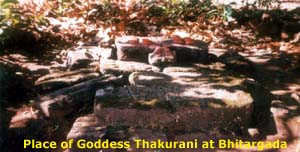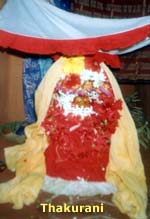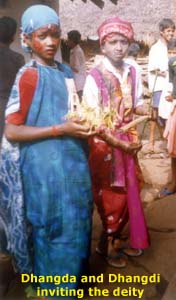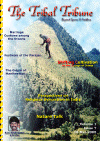Festival of The Parjas
The ‘parji’ speaking Dravidian tribe of Koraput are known as "paraja". It is one of the many tribes residing in Koraput district of Southern Orissa. Its regional fame is partly due to an Oriya novel Paraja by the famous novelist late Gopinath Mohanty(1945), which has been translated into many languages. The tribe Paraja is divided into different sub-groups viz., Sodia, Jadia and Parenga; each of them seems to be a separate ethnic group. The Paraja are claimed as the ancient in-habitants of the Nandapur area of Koraput district of Orissa. ‘Paroja’ is a debased form of Sanskrit "praja" meaning ryot or peasant-subject of the king or feudal lord. The local populace, all composed of tribal groups, were accustomed to observe various festivals. These festivals combine Hindu and tribal rituals. Even after abolition of kingship many festivals or ‘Parab’ (derived from "Parba") are still in vogue. One such ‘Parab’ viz. "Nandi Parab" is described here.
On the first day, soil from anthill is collected, and the priest makes two clay idols ‘dhuli sundari’ and ‘mati sundari’ (dhuli means dust and mati means soil, sundari means beautiful lady). Everyday after puja at pujhari’s house, goddesses are brought to the ‘Sadar’ (village meeting place) where the village virgins dance by holding the idols.
The dancing girls sing traditional songs with drum beatings by the men. The songs speak about the Nandapur King, the beauty of the locality and their pride. Mali Dhangda, Mali Dhangdi Dance: Another important feature of this festival is the dance of Mali Dhangda and Mali Dhangdi (Dhangda/Dhangi means adolescent boy and girl, and Mali a local schedule caste). Two boys of the village (from different clans) perform the dance on the 7th day or on the last day of the festival.
The boys carry bow and arrow and the girls hold the idols of Goddess and visit every house of the village. The villagers invite these well-decorated boys and girls to their houses and welcome them in traditional way. The bow wielding ‘Mali Dhangda’ boys are given castor fruits to shoot with arrow which is enjoyed by all. The 'Mali Dhangdi’ girls hold the auspicious idols which bring happiness to the house.
The Goddess or "Thakurani" is described as incarnation of goddess "Ganga Debata" by the people. The "Thakurani" festival also starts from the Ganga gudi place which is located in Nandapur ancient palace area called "Bhitar gada". As "Ganga" is the most revered river of Hindu and life sustaining river of North India, these Paraja people who are now inhabitants of high plateau of the eastern Ghats, probably once were connected to the Ganga valley. This is presumed because the ‘Nandi’ (debased form of "Nadi" or river) festival is meant for soil fertility. The subject matter of the lyrics of the songs relate to female and sex. The village youth cut such jokes at members of opposite clans ("gotra") relating to sex. During the festival period none digs mother Earth, lest She will be hurt. There are many such folk tales and festivals which can throw light on antiquity of tribal people, their migration and merger with the Hindu. |
Photographs: Author
References :
- Bell R.C. 1945 ‘Orissa District Gazetteer’: Koraput.
- Das Kornel 1999 – Tribal Cultural Heritage and The Culture of Gutab Gadaba tribe of Orissa.
- Mohanty Gopinath – 1945 – "Paraja".
- Sahu Laxmi Narayan 1942.hill Tribes of Jeypore, Servats of Indian Society, Cuttack.
- Schnepel Burkhad 1992, "The Nandapur Suryavamsi: Origin and Consolidation of a South Orissa Kingdom". Orissa Historical Research Journal, 38, P. 170 – 99.
- Sing Deo Bidyadhar 1939, Nandapur: A Forsaken Kingdom, Cuttack Utkal Sahitya Press.
- Ulaka Ramachaqndra 1976, "The Social Life of the Paraja". Adivasi Vol.XVI. SCs TRTI Bhubaneswar, No 2 July P. 21-32.
- Rousselau and Behera, 2002 – 2003, Scheduled Tribe and Forgotten Kings, Ethnohistory of the Joria Paraja in the erstwhile Nandapur – Jeypur Kingdom.








